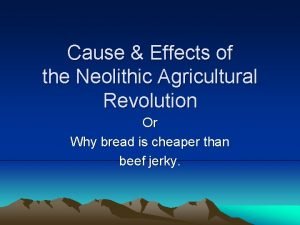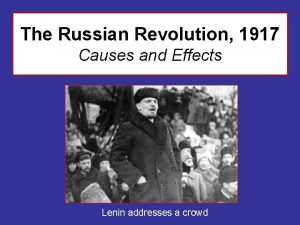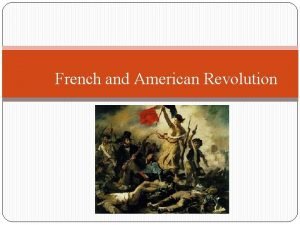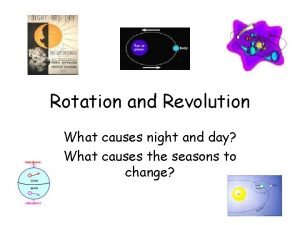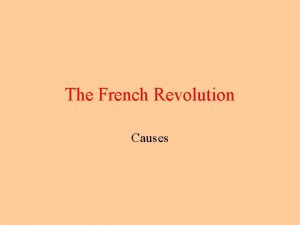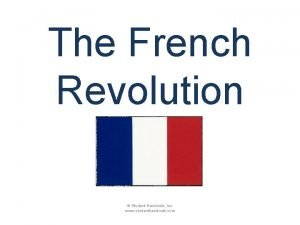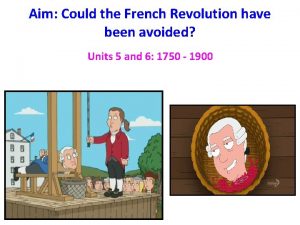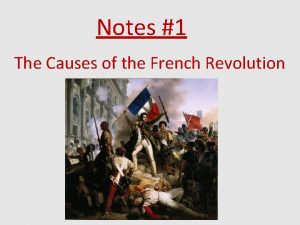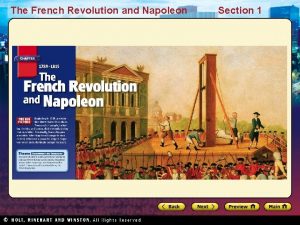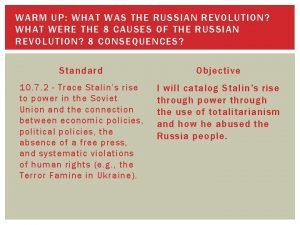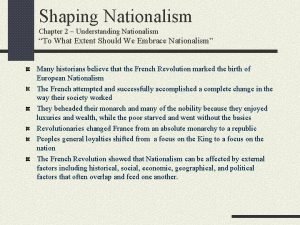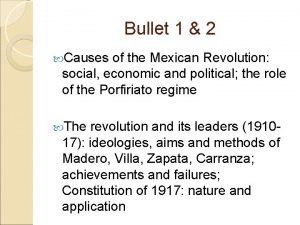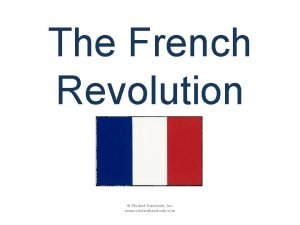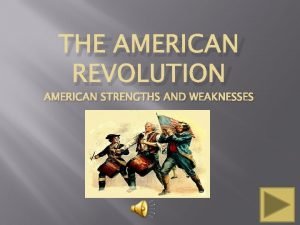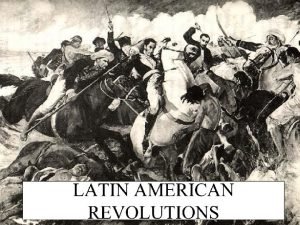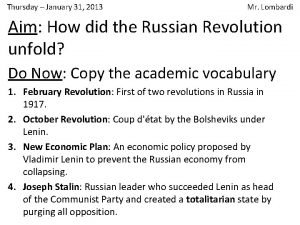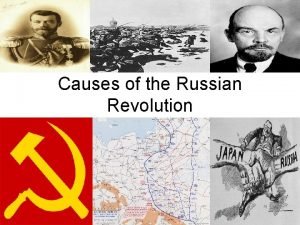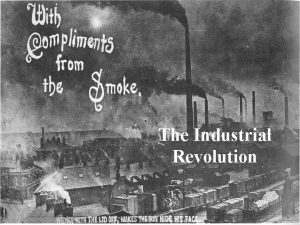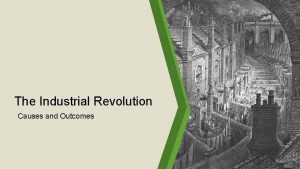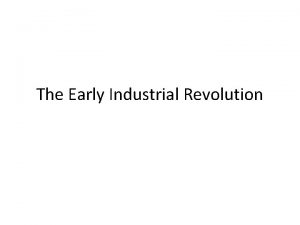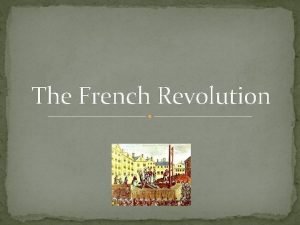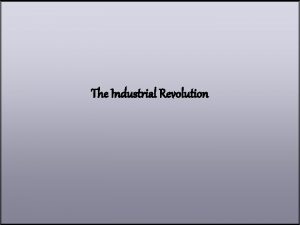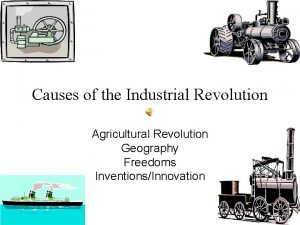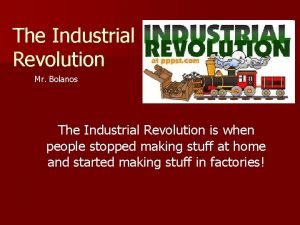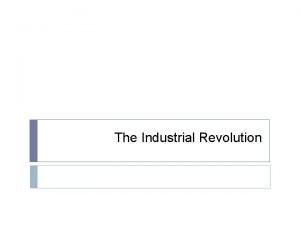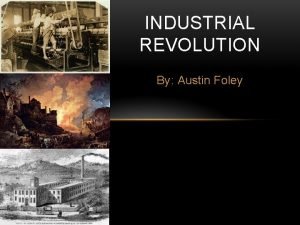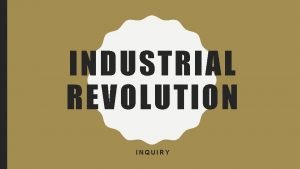The Industrial Revolution 1 What causes revolution 2


































- Slides: 34

The Industrial Revolution 1. What causes revolution? 2. How are these revolutions similar / different?

Important Vocabulary • Capital • Entrepreneur • Industrial Capitalism • Assembly line • Mass Production • Proletariat

Industrial Revolution • The movement and transition to new manufacturing processes that had a large impact on human life. (1780’s – 1840’s) • Two Phases – First – Mostly in Britain, agricultural, manufacturing, steam power – Second- Spread to Western Europe, U. S. , mass production and reactions

Agricultural Developments • Crops spread around the world • New machines decrease labor demand • People move off the land into cities

Water Powered Mill

Steamship and Locomotive

Cottage Industry vs. Assembly Line • Interchangeable Parts • Increased Production • Lower Prices

Population Growth / Urbanization • From 1750 -1850 population in Europe doubled. • Most large cities doubled in size in Europe • Rapid growth of cities led to pitiful living conditions. • Increased Pollution

New Social Classes • Working class: – 12 -16 hour workdays, 6 days a week. – Little employment security and no minimum wage. – Unhealthy working conditions: Coal mines / Cotton mills.

Women and Children • Women and children made up 2/3 of cotton mill workers. • Factory act of 1833 limited children working in factories. • However, most children’s childhood didn’t last past age 9 or 10 when they started work. • Women were mostly relegated to low skill work and marriage was only option.

More Vocabulary • • Socialism Nationalism (pg. 167) Romanticism Realism Natural selection Social Darwinism Suffrage

Free Market Capitalism • Adam Smith – Wealth of Nations 1776 • Definition of 'Free Market' A market economy based on supply and demand with little or no government control.

Supply and Demand Curve

Socialism / Communism • Karl Marx – The Communist Manifesto (1848) • Exploitation of workers causes unrest and revolution • Advocates government ownership of “Means of Production” • Socialism • Unions

Nationalism • Prior to this, people identified more with local, tribal, ethnic groups. • Often times started as a result of conflict and opposition to another nation state. • A nation requires borders, sovereignty, government and a population. • Occurring all around the world in different ways for different reasons.

Dark Side of Nationalism

Nationalism • • • Italy Germany Austria Russia United States (Mr. Stuenkel) Latin America (Mr. Stuenkel)

Nationalism in U. S. • Slavery was divisive issue. – 1 million in 1800 – 4 million in 1860 • Civil war to decide slavery and federalism • United States remain united, see themselves as one country.

Nationalism in Latin America • One example • Jose de San Martin of Argentina • Fought against Spain and won independence • Monroe Doctrine (Warned against European interference in Western Hemisphere)

Public Education • Prior to Industrial Revolution, only for wealthy • Need for highly trained and skilled workers • Political need for educated citizens to participate in democracy / nationalism

Romanticism • An artistic and literary movement based on extreme emotion. • A reaction to the enlightenment and industrial revolution’s reason and calculation • Edgar Allen Poe’s dark literary work. Ex: Tell Tale Heart

Eugene Delacroix • Famous Romantic Artist • Focus on exotic subject matter and extreme color • Battle of Poitiers 1830

Realism • A belief that the world should be viewed realistically (after 1850) • Sought to show realities of life for lower classes • Courbet said, “I have never seen angels nor goddesses, so I am not interested in painting them. ”

Jean-François Millet, The Gleaners, 1857

Modernism • Complete rebellion by artists against beliefs about art • Cameras invented to depict things realistically • Art should function for it’s own sake • Impressionism / Abstract

Van Gogh – Starry Night 1889

Impressionism Monet –Woman with a Parasol - 1875

Cubism – Picasso – Portrait of a Young Girl 1938

Social Reactions to Industrialization • Feminism- the movement for women’s rights – Wanted suffrage for women – 1920 in America (19 th Amendment) – Clara Barton (women’s role in medicine) • Freud and Psychoanalysis- human behavior was strongly determined by past experiences – Trace repressed thoughts all the way to childhood • Social Darwinism-natural selection = the survival of the fittest – Used as a theoretical basis for racism

Industrialization and Imperialism New technology = new weapons Industrial countries can force their will Factories need more raw materials Countries need to sell goods to foreign markets • Early industrial countries are… • • – Britain, France, Belgium, Germany, U. S. , Japan – Colonial regions = SE Asia, Africa, India, Middle East, Mexico

Imperialism in Africa • New Resources Found in South Africa – Diamonds and Gold • Dutch and British fight for control of the region • British win the conflict • South Africa becomes a crown colony • Native groups are kept disenfranchised • Apartheid until 1990’s

Traditional Ethnic Homelands in Africa

Nationalism in Mexico • Porfirio Diaz ruled Mexico from 1877 -1911 supported by wealthy elites and Catholic Church • 95% of rural peasants owned no land • Emiliano Zapata led a peasants revolt • New Constitution in 1917 with male suffrage and land reform

Colonialism in India • British East India Company controls British trade in India • By the early 1800’s the British had conquered most of the Indian sub-continent • The Sepoy (Great) Rebellion – Sepoys = Indian mercenary soldiers – Beef and pork fat cartridge grease • • • 2 years of unrest After the rebellion was put down many believed Britain should rule India directly India was made a crown colony in 1877 Gandhi (Father of non-violent resistance)
 Ultimate vs proximate causation
Ultimate vs proximate causation Proximate causation vs ultimate causation
Proximate causation vs ultimate causation Water pollution introduction
Water pollution introduction Whats the scientific revolution
Whats the scientific revolution French revolution causes
French revolution causes Cause and effects of the neolithic revolution
Cause and effects of the neolithic revolution Causes and effects of the russian revolution
Causes and effects of the russian revolution The effects of the french revolution
The effects of the french revolution What causes night and day
What causes night and day What are the main causes of french revolution
What are the main causes of french revolution The causes of the french revolution
The causes of the french revolution Short term causes of the french revolution
Short term causes of the french revolution Could the french revolution have been avoided
Could the french revolution have been avoided Haitian
Haitian 2nd estate
2nd estate France story
France story French revolution
French revolution Russian revolution causes and effects
Russian revolution causes and effects Causes and effects of the french revolution
Causes and effects of the french revolution Cause of english civil war
Cause of english civil war French revolution causes and effects
French revolution causes and effects Social causes of french revolution
Social causes of french revolution What were the causes of the mexican revolution
What were the causes of the mexican revolution Short term causes of the french revolution
Short term causes of the french revolution You should hope that this game will be over soon
You should hope that this game will be over soon French revolution causes
French revolution causes Why do we have seaosns
Why do we have seaosns American revolution strengths and weaknesses
American revolution strengths and weaknesses Latin american revolution causes
Latin american revolution causes Economic causes of french revolution
Economic causes of french revolution Causes of the russian revolution
Causes of the russian revolution Causes and effects of the russian revolution
Causes and effects of the russian revolution Committee of public safety
Committee of public safety French revolution causes and effects
French revolution causes and effects How do new ideas spark change
How do new ideas spark change





